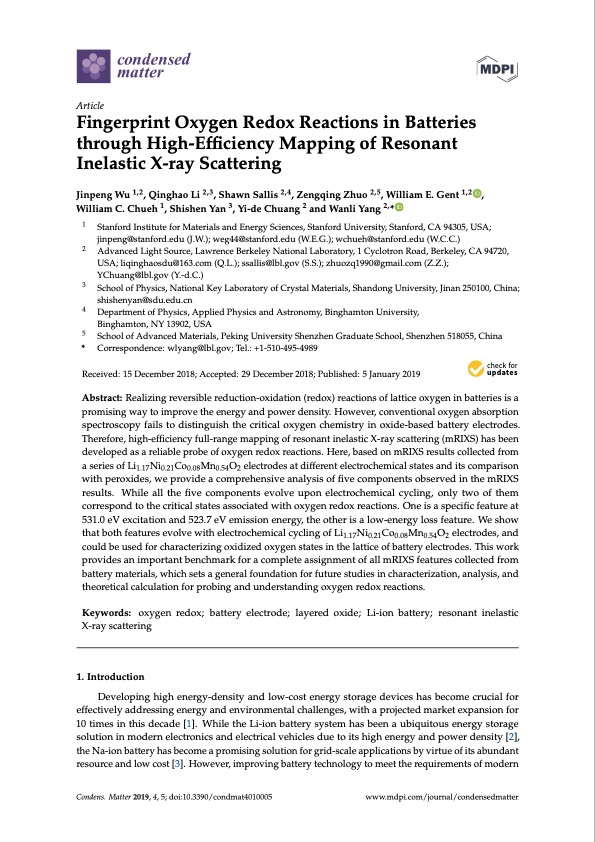
PDF Publication Title:
Text from PDF Page: 001
Article Fingerprint Oxygen Redox Reactions in Batteries through High-Efficiency Mapping of Resonant Inelastic X-ray Scattering Jinpeng Wu 1,2, Qinghao Li 2,3, Shawn Sallis 2,4, Zengqing Zhuo 2,5, William E. Gent 1,2 , William C. Chueh 1, Shishen Yan 3, Yi-de Chuang 2 and Wanli Yang 2,* 1 2 3 4 5 Received: 15 December 2018; Accepted: 29 December 2018; Published: 5 January 2019 Stanford Institute for Materials and Energy Sciences, Stanford University, Stanford, CA 94305, USA; jinpeng@stanford.edu (J.W.); weg44@stanford.edu (W.E.G.); wchueh@stanford.edu (W.C.C.) Advanced Light Source, Lawrence Berkeley National Laboratory, 1 Cyclotron Road, Berkeley, CA 94720, USA; liqinghaosdu@163.com (Q.L.); ssallis@lbl.gov (S.S.); zhuozq1990@gmail.com (Z.Z.); YChuang@lbl.gov (Y.-d.C.) School of Physics, National Key Laboratory of Crystal Materials, Shandong University, Jinan 250100, China; shishenyan@sdu.edu.cn Department of Physics, Applied Physics and Astronomy, Binghamton University, Binghamton, NY 13902, USA School of Advanced Materials, Peking University Shenzhen Graduate School, Shenzhen 518055, China * Correspondence: wlyang@lbl.gov; Tel.: +1-510-495-4989 Abstract: Realizing reversible reduction-oxidation (redox) reactions of lattice oxygen in batteries is a promising way to improve the energy and power density. However, conventional oxygen absorption spectroscopy fails to distinguish the critical oxygen chemistry in oxide-based battery electrodes. Therefore, high-efficiency full-range mapping of resonant inelastic X-ray scattering (mRIXS) has been developed as a reliable probe of oxygen redox reactions. Here, based on mRIXS results collected from a series of Li1.17Ni0.21Co0.08Mn0.54O2 electrodes at different electrochemical states and its comparison with peroxides, we provide a comprehensive analysis of five components observed in the mRIXS results. While all the five components evolve upon electrochemical cycling, only two of them correspond to the critical states associated with oxygen redox reactions. One is a specific feature at 531.0 eV excitation and 523.7 eV emission energy, the other is a low-energy loss feature. We show that both features evolve with electrochemical cycling of Li1.17Ni0.21Co0.08Mn0.54O2 electrodes, and could be used for characterizing oxidized oxygen states in the lattice of battery electrodes. This work provides an important benchmark for a complete assignment of all mRIXS features collected from battery materials, which sets a general foundation for future studies in characterization, analysis, and theoretical calculation for probing and understanding oxygen redox reactions. Keywords: oxygen redox; battery electrode; layered oxide; Li-ion battery; resonant inelastic X-ray scattering 1. Introduction Developing high energy-density and low-cost energy storage devices has become crucial for effectively addressing energy and environmental challenges, with a projected market expansion for 10 times in this decade [1]. While the Li-ion battery system has been a ubiquitous energy storage solution in modern electronics and electrical vehicles due to its high energy and power density [2], the Na-ion battery has become a promising solution for grid-scale applications by virtue of its abundant resource and low cost [3]. However, improving battery technology to meet the requirements of modern Condens. Matter 2019, 4, 5; doi:10.3390/condmat4010005 www.mdpi.com/journal/condensedmatterPDF Image | Oxygen Redox Reactions in Batteries Resonant Inelastic X-ray Scattering

PDF Search Title:
Oxygen Redox Reactions in Batteries Resonant Inelastic X-ray ScatteringOriginal File Name Searched:
condensedmatter-04-00005.pdfDIY PDF Search: Google It | Yahoo | Bing
Sulfur Deposition on Carbon Nanofibers using Supercritical CO2 Sulfur Deposition on Carbon Nanofibers using Supercritical CO2. Gamma sulfur also known as mother of pearl sulfur and nacreous sulfur... More Info
CO2 Organic Rankine Cycle Experimenter Platform The supercritical CO2 phase change system is both a heat pump and organic rankine cycle which can be used for those purposes and as a supercritical extractor for advanced subcritical and supercritical extraction technology. Uses include producing nanoparticles, precious metal CO2 extraction, lithium battery recycling, and other applications... More Info
| CONTACT TEL: 608-238-6001 Email: greg@infinityturbine.com | RSS | AMP |